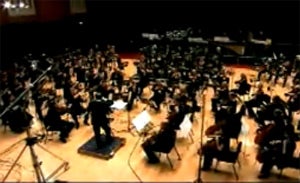15 million hits later, YouTube Symphony makes live debut

Your support helps us to tell the story
From reproductive rights to climate change to Big Tech, The Independent is on the ground when the story is developing. Whether it's investigating the financials of Elon Musk's pro-Trump PAC or producing our latest documentary, 'The A Word', which shines a light on the American women fighting for reproductive rights, we know how important it is to parse out the facts from the messaging.
At such a critical moment in US history, we need reporters on the ground. Your donation allows us to keep sending journalists to speak to both sides of the story.
The Independent is trusted by Americans across the entire political spectrum. And unlike many other quality news outlets, we choose not to lock Americans out of our reporting and analysis with paywalls. We believe quality journalism should be available to everyone, paid for by those who can afford it.
Your support makes all the difference.Even before they played their first note together, the YouTube Symphony Orchestra were listed as one of the world's most inspiring orchestras.
Part publicity stunt by its producers, part vanity trip by its participants, part opportunity to attract a younger crowd to classical music, the orchestra made its much anticipated debut last night at Carnegie Hall in New York.
In the four months since the project was announced, more than 3,000 videos submitted by amateur and professional musicians from 70-plus countries were auditioned.
Voters among the 15 million viewers of www.YouTube.com/Symphony selected the 93 winners, who ranged from ages 15 to 55 and included a surgeon-violinist and a professional poker player-cellist.
"We're meeting a lot of different worlds," conductor Michael Tilson Thomas told the audience before the first downbeat, "the real time world, the online world and the experience of getting acquainted. For us it's been something between a classical music summit conference (and) scout jamboree combined with speed dating."
Only last month, the prestigious British magazine Gramophone placed the group among the 10 most inspiring orchestras, praising it "for democratising classical music on a global scale, making it truly all-inclusive."
"It's turned classical music into something everybody's talking about, huge numbers are engaging, thinking about and also understanding it could be something for them," Carnegie Hall Executive Director Clive Gillinson said in an interview.
But could the group play together in a live performance, with only a few days of rehearsals, and at one of the world's leading classical music venues?
"Playing at Carnegie Hall is such a thrill to me," 36-year-old flutist Nina Perlove of Cincinnati, Ohio said in an interview. "I actually didn't think I'd be so moved because I'm a professional musician and I've played in nice concert halls before. But when we walked out on stage for the first time and I looked out, I got kind of watery. I was thinking about my grandfather who loved New York and was a musician and how he would be so moved."
From the joyous third movement of Brahms' Fourth Symphony, which opened the concert to the fiery crashes of Tchaikovsky's Fourth Symphony at the end, Thomas led the musicians in a remarkable performance.
In between these immortal pillars, the orchestra played a wide assortment of works, including challenging pieces by Lou Harrison, Heitor Villa-Lobos, John Cage and the world premiere of Tan Dun's "Internet Symphony No. 1, Eroica."
Watch the orchestra perform at Carnegie Hall
Despite the short preparation time, they played like a finely tuned instrument. For example, the string players' bows moved in synch and flew through the air at rousing conclusions.
The musicians, who come from more than 30 countries, arrived in New York on Sunday. During rehearsals, they were coached by leading orchestral musicians, including Roberto Diaz, president of the Curtis Institute of Music and former principal violist with the Philadelphia Orchestra.
"It was a very talented group of individuals," Diaz said in an interview. "Every rehearsal, it's just gotten better and better, and they've gotten this sense of group rhythm, which is a fundamental part of it all. ... To do that in 48 hours is amazing."
The internet generation of performers attracted a youthful crowd that had no reason to feel shy. The staid decorum was suspended for the three-hour concert, which featured 15 short pieces. Thomas sat on the podium at one point, watching pianist Yuja Wang fly through the "Flight of the Bumble Bee." Images of musical notes, geometric patterns and of the players were projected on the walls and ceiling, and the audience was encouraged to bring video cameras.
One of the many high points was Tan's 4½ minute "symphony," a high-octane work conducted by the composer who packed it with hammer whacks on hanging tire hubs, a cinematic melody and references to Beethoven's "Eroica."
Other outstanding performances were given by soloists Joshua Roman on cello, the violinist and guest star Gil Shaham, soprano Measha Brueggergosman (singing the gibberish lyrics in Cage's bizarre "Aria with Renga") and Mason Bates playing the Apple computer synthesizer in his thumping electronic "Warehouse Medicine from B-Sides."
The show was nearly stolen by three youngsters mentored by the pianist Lang Lang — 8-year-old Charlie Liu of Plainsboro Township, New Jersey; Anna Larsen, also 8, and fellow Boston resident Derek Wang, 10. They plopped down on a bench and played a six-hand waltz by Rachmaninoff without a hitch, then took their bows to the audience's delight.
Join our commenting forum
Join thought-provoking conversations, follow other Independent readers and see their replies
Comments